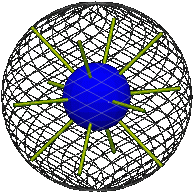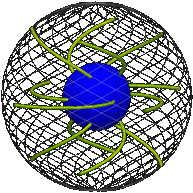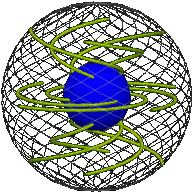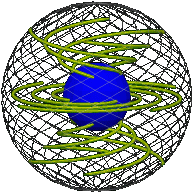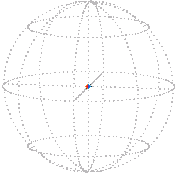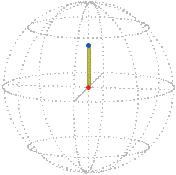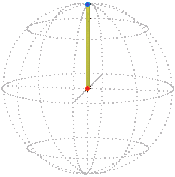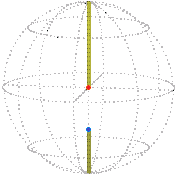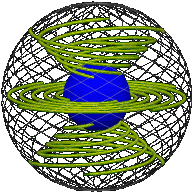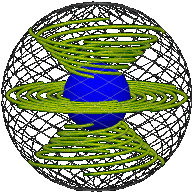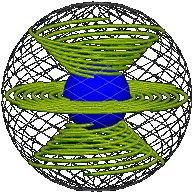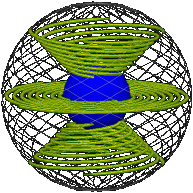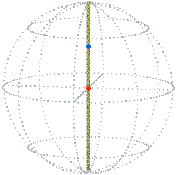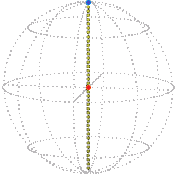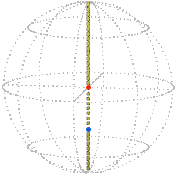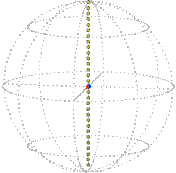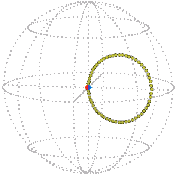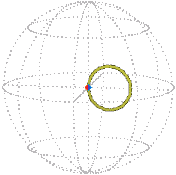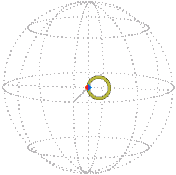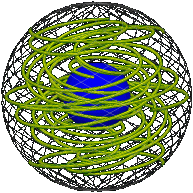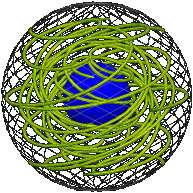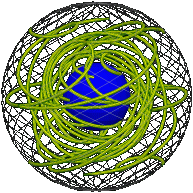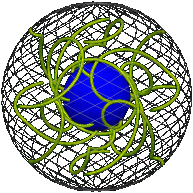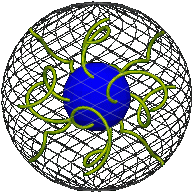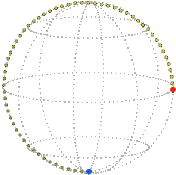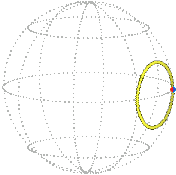P.A.M. Dirac was an English theoretical physicist famous for his relativistic theory of quantum mechanics which he developed in the 1920s. In the course of that work he investigated the concept of orientation, that is, the position of an object with regard only to how it is turned or tilted.
Consider an object that can rotate in any way about a fixed point but cannot move otherwise. If the object is flat and confined to a plane you can describe its position with just one number. First designate one position of the object as the reference position, then any other position can be obtained from this reference position by rotating about the fixed point. The angle of rotation can be constrained to be less than 360° and greater than or equal to zero, and that would cover all possible positions.
If the object is a solid in space the problem is more complicated. One solution is analogous to that in the plane and uses the following fact, discovered in the 18th century by the Swiss mathematician Leonhard Euler: the general displacement of a rigid body with one point fixed can be obtained by one rotation about some axis passing through the fixed point. This isn’t obvious, but being true it gives a simple way to specify the position of the object. Again designate one position of the object as the reference position. Since any other position can be obtained by starting from the reference position and rotating about an axis, represent the position by that direction (the axis of rotation) together with the angle (how much to rotate).
However the many possible positions of an object are described, they could be considered all at once as a sort of “space” itself – in other dimensions – each “point” of this space representing one position. A movement of the object (about its fixed point) from one position to another would be represented in this “position space” by a path from one point to another.
The position space is connected in a peculiar manner and Dirac thought of a simple way to illustrate it. We go into more detail in the succeeding sections. Since the position space is the same for any object whatever its shape or size, we will be specific by making the object a sphere and the fixed point its center. [0]
0. Dirac’s “string trick” employed two strings tied to the handles of a pair of scissors. The earliest published mention is “On a string problem of Dirac” by M.H.A. Newman, J. London Math. Soc., vol. 17 (1942). Dirac called it the “scissors puzzle” in a letter to Newman seven years before that.
Suppose a sphere’s center is fixed but the sphere is otherwise free to turn in any way. How can we distinguish and label each of the positions the sphere could occupy?
First consider the sphere in some arbitrary position. As we claimed before, the sphere at any other position can be thought of as the result of rotating the sphere starting from that first position. Call the first position the reference position.
It isn’t obvious that any position can be reached from the reference position by just one rotation, that is, directly turned about one axis with no wobbling. We won’t prove it hear but in fact, given any two positions of the sphere there always exists a rotation, about a certain axis through a certain angle, that will take the sphere from the one position to the other. Furthermore, the angle can be required to be between 0 and 180° inclusive. This rotation is unique if the angle is not 0 or 180°, that is, if it is strictly within the range 0 to 180°.
This axis-angle can be represented by a vector: an arrow in the line of the axis, with its length equal to the rotation angle (using some arbitrary factor to convert angle units into distance units, say 1 for 1 radian). [1] The vector is unique if we agree to ignore the difference between two vectors in opposite directions when the angle of rotation (the length of the vector) is 180°, because rotating the sphere through 180° about either vector gives the same final position. [2]
1. We need to choose which of the two ways along the axis to point the arrow. Given the same axis and angle, we want always to choose the same direction, and we want the vector to vary continuously as position varies. Given these two conditions we need choose arbitrarily for only one non-zero rotation, all the others then follow by continuity. We choose the direction so that the rotation appears counterclockwise as you look against the arrow. This is the same direction as given by the “right hand rule”: grasp the axis with your right hand so your fingers curl with the sweep of the rotation, then point the vector in the direction of your thumb.
The reason a 180 degree span will do instead of 360 is that the axis can be in any direction, and – 180 about a given axis is the same as 180 about the negative axis.
2. The axis/angle corresponding to the zero rotation, which leaves the sphere stationary, is not unique (any axis would serve). But the corresponding vector (zero) is unique.
In this way we construct a vector that represents the position of the sphere; we can recover the rotation given the vector. Now regard this vector as the position vector of a point in Euclidean space. [3] The point lies in what we shall call the position space of the sphere. [4] It is a ball of radius π radians, but with the proviso that diametric points on its surface are thought of as interchangable – because they represent one and the same position of the sphere. [5] The center of this ball represents the reference sphere. Any other point represents the position obtained by rotating the reference sphere about the point’s position vector, through an angle equal to its length. [6]
3. If a is the unit axis vector and θ the angle of rotation then the position vector p = θ a.
4. It would be a mistake to call this space the rotation space of the sphere. That would be like calling a plane the translation space of the plane. They do, however, naturally correspond with each other.
5. We could allow instead the radius to be 2 π radians with the entire surface identified as one position. Then the ball would cover the actual positions twice over, and every point a certain distance from the center would have to be identified with the point in the opposite direction the same distance from the surface.
The position space of the sphere is a manifold of three dimensions, and is connected like projective three-space. To give some idea what this means, imagine a right-hand glove placed at the center of position space and then moved outward over the pi bounding surface. It would come in again on the opposite side, and it would still be a right-hand glove.
Any slice through the center is a disk with opposite sides identified. It is connected like the projective plane. (A figure in this plane that moved as described above would turn into its mirror image.)
6. A point in position space determines the individual points of a sphere as follows. Let p be the position vector of a point in position space, and r a point on the reference sphere. Let θ be the length of p and a the unit vector in its direction. That is, θ = | p | and a = p/θ. Standard vector analysis yields the rotation formula, expressed using the dot and cross product of vectors:
Note that the radius of the sphere does not enter into what we have been calling its position. We can compare the positions of large and small spheres using the same position space, given that their positions are the same when both are in their reference positions. In what follows we will use “sphere position” in this sense of “sphere orientation” and disregard the sphere’s radius.
We will call the reference position zero.
After setting up a rectangular coordinate system for the natural space of the sphere, the same coordinate system can be used in the position space even though that space is an abstract space. Position space was obtained by regarding the rotation vectors in the sphere’s natural space as position vectors of points in the abstract space. We can use the same coordinate system in both spaces. (Say the x-axis goes to the right, the y-axis into the screen, the z-axis up.)
7. A path between two points p0 and p1 in a space P is a function f : [0,1] → P from the unit interval into the space, with f (0) = p0 and f (1) = p1. The parameterization is included in the idea of a path, not just its image in the space.
For example, a simple rotation about the vertical by π / 2 (90°) that starts from the reference position (zero) is represented in position space by a radial line segment. The orange dot is at the starting position, the blue dot is at the ending position:
| Position space. |
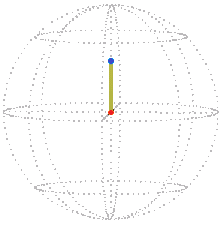 |
There is another way to record the movement of a sphere, within its natural space rather than an abstract space. First consider a similar problem. Suppose we wanted to record the motion of a square sliding about in the plane. If we were to move that plane perpendicular to itself at a steady speed, the square would sweep out a solid. This timeless solid would be a record of all the positions the square had occupied during the course of its travel in the plane. The time t in the plane becomes the distance t perpendicular to the plane.
We have a sphere rather than a flat square, but a similar idea works: shrink the sphere at a constant rate. The resulting solid records the motion of the sphere. (The well known model of the tesseract or hypercube, the four-dimensional cube, uses a similar idea. Our solid is like the lateral surface of a four dimensional cylinder with the outer and inner spheres as its two end caps.) The outer sphere represents the sphere at its starting position, the inner sphere represents the sphere at its final position.
| Real space. | |
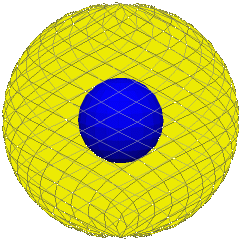 | ······· t = 0 rim ······· t = 1 core |
Later we will be considering “motions of the motion,” so think of the solid as made of elastic material attached to the inside surface of the rigid rim and to the outside surface of the rigid core.
Imagine the elastic divided into innumerable concentric spheres between the rim and core. We shall call any such intermediate sphere between the rim and core an intersphere. The collection of interspheres records the motion of a sphere. Each sphere at a different time is an intersphere. The reference position (zero) is the rim and the final position is the core.
Now we have two ways of representing the motion of a sphere: either as a path in position space starting at zero, or as a particular position of the elastic between rim and core. Canceling out the mediating idea of the moving sphere leads to the following observation:
We will let the point that is t of the way along the path correspond to the intersphere t of the way from the rim to the core, where t goes from 0 to 1. Note that t now indicates a radial distance inward rather than a time.
The simple path in position space illustrated in the previous section translates into a position of the elastic illustrated below at right, where we show only a few “ropes” within the elastic. The point, depicted as a dot, in position space representing the rim is colored orange (always at the center) and that for the ball blue.
| Position space. | Real space. |
 |  |
There is a special position of the elastic whose corresponding path we will need to know, namely its initial position when the elastic is untwisted. The path for this begins at zero and stays there because all the interspheres, including the core, are in the same position as the rim. The following shows the path in position space (the dot is colored half orange and half blue) and the corresponding position of the elastic indicated by a few ropes within it.
| Position space. | Real space. |
 | 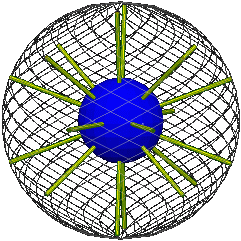 |
The “continuous elastic material” can be represented by a function on the space between the rim and core. However, colloquial language handles motion more easily than mathematical notation. The problem with mathematical notation is that in order for a point to retain its identity in another position, one must resort to a function. [8]
8. Let E be the space between and including the rim and core. An intersphere is any sphere concentric to the rim and core within E.
Let S be the collection of interspheres S (t), t = 0 to 1, where S (0) is the stationary rim, S (1) the core, and in general
where R and C are the radii of the rim and core respectively.
E is the disjoint sum of S, that is E can be divided into separate interspheres S (t) where t = 0 to 1.
Any one-to-one function of E onto E determines a “position of E,” or rather by the latter is meant the former!, like a rotation determines a position of a sphere. We start with an untwisted elastic identified with E and then other positions of the elastic can be defined as the result of an autohomeomorphism applied to E.
Using a function to define the position of E overcomes the problem that E is always E. One needs to use the function to describe the “position of E” rather than simply E by itself. E is space, the function is or represents the elastic.
We require of the function f : E → E that for any intersphere S, f restricted to S merely moves S in place, that is, about its center. In other words f |S is a rotation. We also require that when S = S (0), f |S = IS the identity map. In other words the rim is fixed.
Let P be position space. A path in P starting at zero, call it g : [0,1] → P where g(0) = 0, determines a position of the elastic, that is, a function on E per above, as follows. First identify P with rotations, so that any p in P acts on the points of a sphere S by rotating them, s to p⋅s. For each t, g (t) is such a p and S (t) such a sphere, and thus we have the rotated points of S (t) given by g (t) ⋅ s, s in S (t). In other words g (t) ⋅ S is S rotated.
Now let e be a point of E. Then e lies on exactly one sphere of S, namely S (t) where t is the distance of e from the rim. Let g (t) rotate S (t), and in particular move e to a new point e’ in E. Doing this for all e in E defines an autohomeomorphism of E, a new position of E given a starting position.
To repeat: a path in P determines a one-to-one function of E onto E, which defines a position of the elastic given an initial position.
Elastic motion ↔ Path motion
As the motion progresses the imaginary interspheres slide against one another, shearing and twisting at different points in between, while each remains rigid and within itself.
Here is the core turning about exactly once about the vertical axis, the elastic passively following, as represented in real space and position space (snapshot each quarter turn). Imagine a sphere shrinking as it turns, each circle on it tracing out a rope:
